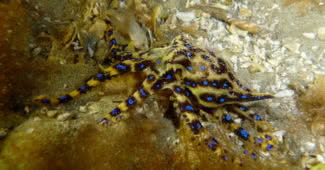The ocean is home to diverse sea creatures, making it a vibrant ecosystem. However, humans are vulnerable when exploring the deep sea due to potential breathing difficulties, unexpected attacks from animals with sharp teeth, or strong bite force. While some sea creatures are gentle, others can be hazardous and cause painful stings that may require hospitalization or lead to death.
Below is a list of the ten most dangerous sea creatures that greatly threaten humans.
10Lionfish
Biologists consider lionfishes one of the most aggressively invasive species as they pose a potential threat to the delicate reef ecosystems of the Mediterranean and Atlantic. They also cause a severe threat to commercial fish species like scamp grouper in the US. Since they have no natural predators reducing their population helps combat the threat to natural ecosystems and local fishing economies.
9Sea snake
Sea snakes possess highly toxic venom, but their bites may not be painful. Most instances of snake bites reported are from fishermen while removing the snakes from their fishing nets or accidentally stepping on them while wading in seawater. Symptoms usually appear within minutes to hours, including dizziness, weakness, difficulty speaking or swallowing, pain, respiratory collapse, and sometimes coma.
Sea snakes, in general, are not aggressive and always try to avoid human contact. They use their sharp fangs to bite and are as venomous as other terrestrial snakes. However, some specific species, like the yellow-bellied sea snake, are more vicious and are among the most poisonous snakes on the planet.
10 Most Poisonous Animals In The World
8Cone Snail
Cone snails are marine snails that have beautiful conical shells and distinct color patterns. However, they possess a harpoon-like tooth that can inject a potent neurotoxin that harms humans. Over 600 known species of cone snails, all are poisonous. These snails prefer to live in shallow reefs covered partially by sandy sediment or coral in tropical and subtropical waters.
Their toxicity can still cause death within 5-8 hours of envenomation. Those dealing with cone snails should wear proper gloves, and swimmers should avoid carrying live cones close to their skin. Educating patients on the proper care of chronic wounds with ulceration caused by cone snails is essential.
7Sting Ray
The barb goes deep into the skin to release venom. Lifeguards trained in first aid for stingray stings often carry large buckets to soak the affected foot, which can help ease the pain. Depending on the species that stung, a person may experience symptoms like nausea, dizziness, and fever, but most people only have localized pain.
6Barracuda
Their speed makes them effective hunters, but generally, they are not poisonous. It is not advisable to eat barracuda because they may carry ciguatera poisoning caused by consuming certain plankton that generates toxins. Avoiding rapid movements, limiting splashing, and refraining from wearing flashy jewelry help prevent attacks from barracudas.
5Salt Water Crocodile
They are excellent at hiding in the murky waters. The sudden movement of their powerful tail helps them attack prey. They exhibit a bite force ten times greater than a great white shark. Moreover, it has been reported that saltwater crocodiles can cause thousands of human fatalities annually.
4Stonefish
Stonefish resemble encrusted rocks and come in various colors, including brown, grey, yellow, orange, and red. They wait for prey to swim past and strike them with incredible speed. So, to record the feeding of this species accurately, a high-speed camera is essential. While they typically won’t attack humans, stepping on them can be dangerous.
When disturbed, they erect their poisonous dorsal fin spines, which can inject a highly toxic venom that causes intense pain, swelling, necrosis, and even death. Even though hot water provides some relief, quick medical treatment is necessary. Stonefish venom can cause potential harm to the cardiovascular and neuromuscular systems.
3Flower Urchin
The flower urchin is the most dangerous type of sea urchin, and its most notable feature is its pedicellariae. Unlike other venomous sea urchins, the flower urchins inject their venom through their flower-like globiferous pedicellariae. This venom causes respiratory problems, severe pain, and paralysis. Flower urchins pose a potentially lethal threat to scuba divers.
When undisturbed, the tips of the pedicellariae are rounded cup-like, with tiny sensors on their inner surfaces that detect threats by touch or chemical stimuli. If a potential threat brushes against them, the pedicellariae immediately inject venom, and their claws can break off and adhere to the point of contact, continuing to inject venom for hours.
2Blue Ringed Octopus
Blue-Ringed Octopuses are cephalopods that are highly venomous and commonly found in the Pacific and Indian Oceans. They come out at night to hunt small fishes and crustaceans, as they are nocturnal. If they feel threatened, they quickly change color to display blue patterns on top of a yellow or cream-colored base.
The salivary glands of blue-ringed octopuses contain symbiotic bacteria that produce tetrodotoxin (TTX), a potent neurotoxin that blocks the transmission of nerve impulses. It can cause deadly consequences by stopping muscles from contracting. There have been reports of human poisoning from accidentally eating a blue-ringed octopus. Additionally, these octopuses can inject TTX via a painless bite.
Related Articles
1Box Jellyfish
Box jellyfish are named for their distinctive body shape, and they have tentacles covered in tiny darts called nematocysts. Loaded with poison, these darts can cause paralysis, cardiac arrest, and even death in humans and animals within minutes of being stung. Despite their harmless appearance, the sting from a box jellyfish is extremely dangerous.
Of the many lethal varieties, the Australian box jellyfish is considered one of the most vicious marine animals. The exceptional speed and vision of Box Jellyfish help them hunt small fish and shrimp. The venom is one of the deadliest, and even the survivors of a sting may experience significant pain for several weeks.




